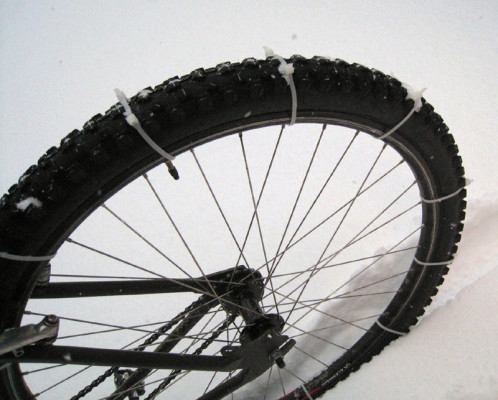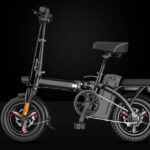Unexpected snowfall can disrupt daily routines, but for cyclists, it presents a unique challenge and opportunity. When a blanket of snow descended, transforming roads and trails into a winter wonderland, the question arose: how to keep biking? While studded snow tires are the ultimate solution, a quick, do-it-yourself approach using zip ties offered a surprisingly effective alternative for navigating snowy and icy conditions.
 DIY Zip Tie Snow Tires for Enhanced Winter Bike Traction
DIY Zip Tie Snow Tires for Enhanced Winter Bike Traction
My Experience with Zip Tie Snow Tires
Inspired by online DIY communities, I decided to test the zip tie snow tire concept on my singlespeed 29er. Lacking dedicated snow tires and facing a city covered in snow, improvisation was key. Standard 8-inch zip ties proved slightly short for my wider tires, leading to the use of two ties per section. This resourceful adaptation, however, turned out to be advantageous. The doubled zip ties provided two points of contact on the tire tread, effectively enhancing grip in the snow and ice.
The results were immediately noticeable. Riding on snow-covered roads and trails, the zip tie modifications on the rear wheel delivered impressive traction. As the week progressed and the snow transitioned to ice, these makeshift snow chains continued to perform admirably. They provided sufficient grip even on icy inclines, where sledding activity had further polished the surface. This DIY solution allowed for confident cycling in conditions that would typically render standard bike tires useless.
Why Consider DIY Snow Tires?
While professional Bike Snow Tires, especially studded tires, offer superior and reliable performance in harsh winter conditions, DIY zip tie snow tires serve as a practical short-term or budget-friendly alternative. For areas with infrequent snowfall or for cyclists wanting to experiment with winter biking without a significant investment, this method is worth considering. It allows you to gain traction in light to moderate snow and ice, extending your biking season and opening up winter trails.
However, it’s crucial to acknowledge the limitations. Zip tie snow tires are not a replacement for dedicated winter tires in severe icy conditions or for regular winter commuting. They are best suited for slower speeds and careful riding on softer snow and ice. Durability is also a factor; zip ties will wear down with use, especially on abrasive surfaces.
Important Considerations and Safety Tips
For those attempting this DIY approach, several factors are important:
- Brake Type: Disc brakes are ideal for zip tie snow tires as they provide ample clearance. With V-brakes, ensure sufficient clearance to avoid interference and consider disabling the rear brake to prevent damage, as demonstrated in the original test.
- Bike Compatibility: Check for adequate clearance between the tires and frame, particularly chain stays and fenders, to prevent rubbing. Mountain bikes and some hybrid bikes generally offer more clearance.
- Installation: Securely fasten zip ties around the tire, ensuring they are tight enough to stay in place but not so tight as to damage the tire. Regularly inspect zip ties for wear and tear during and after rides.
- Safety First: DIY snow tires provide enhanced traction but do not eliminate the risks of winter cycling. Ride cautiously, reduce tire pressure slightly for better grip, and avoid hard braking or sharp turns on ice. Always prioritize safety and wear appropriate winter cycling gear.
Conclusion: Embrace Winter Biking with Resourcefulness
DIY zip tie snow tires offer a testament to resourceful problem-solving for cyclists facing snowy conditions. While not a long-term solution or replacement for professional winter tires, they provide a surprisingly effective way to gain traction and enjoy biking in light snow and icy conditions. For cyclists seeking a temporary, affordable, and DIY approach to winter biking, experimenting with zip tie snow tires can be a worthwhile and adventurous endeavor. Just remember to prioritize safety, ride responsibly, and consider investing in proper bike snow tires if winter cycling becomes a regular activity.

